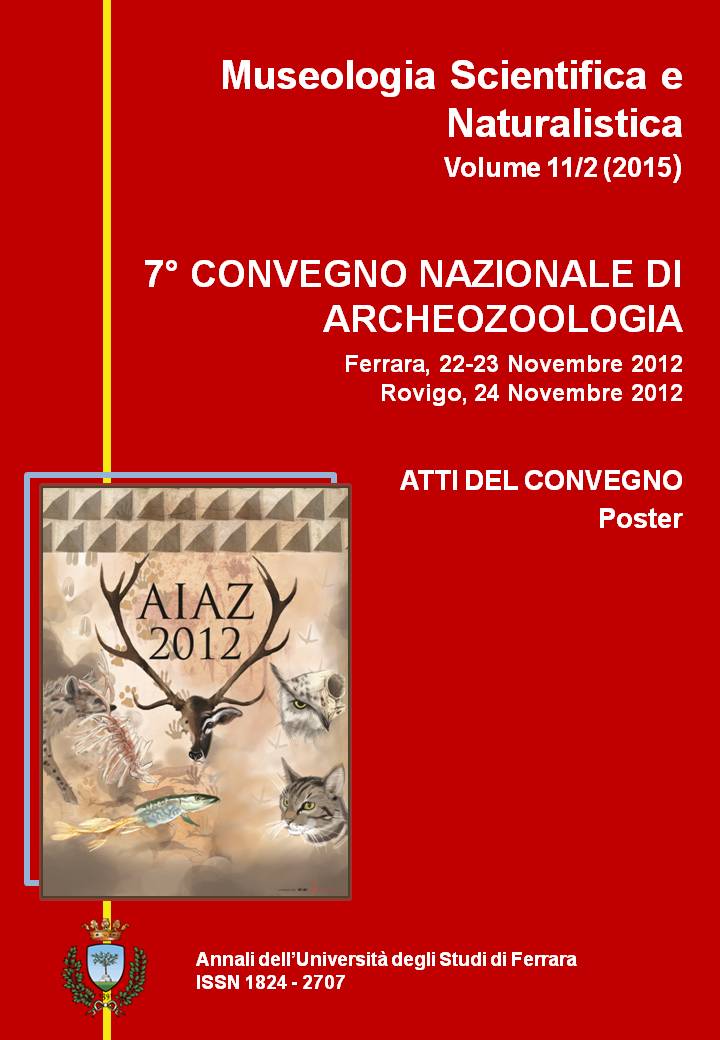I resti faunistici dell’età del Rame del Col del Buson, Valle dell’Ardo (Belluno). Aspetti archeozoologici e paleoeconomici
DOI:
https://doi.org/10.15160/1824-2707/1044Abstract
Riassunto - La località Col del Buson è ubicata sulla destra idrografica dell’Ardo, torrente prealpino affluente del Piave. L’insediamento frequentato dal tardo Neolitico a tutta l’età del Rame occupa la parte sommitale di un rilievo roccioso (m 715 slm), che è caratterizzato da due creste contrapposte e da una depressione centrale di origine naturale. Indagini archeologiche pluriennali hanno consentito di accertarne la natura d’insediamento permanente o quantomeno a lungo ciclo stagionale (primavera-autunno).
L’analisi faunistica, fondata su circa 800 reperti determinati provenienti dagli strati dell’età del Rame, tende ad indicare un quadro abbastanza tipico delle faune eneolitiche, momento in cui l’approvvigionamento di carne non si basa più prevalentemente sulla caccia ma può contare in misura crescente sull’apporto delle faune domestiche. Gli animali d’allevamento, in prevalenza buoi e caprovini, costituiscono l’85% dell’intero lotto mentre i selvatici sono dominati dal cervo, anche se è testimoniata la caccia, seppur sporadica, al capriolo, al cinghiale e al camoscio.
La struttura della fauna del Col del Buson può essere ben accomunata ad altri siti neolitici ed eneolitici del Nord-Est italiano come Colombare di Negrar e Gazzo Veronese, dove l’economia, anche se ancor basata in parte sulla caccia, si rivolge sempre più allo sfruttamento degli animali domestici.
Summary - The Copper Age faunal remains from Col del Buson, Valle dell’Ardo (Belluno). Archaeozoological and palaeoeconomic aspects
The site of Col del Buson lies on the right bank of the Ardo, a prealpine stream and tributary of the Piave. The settlement, in usefrom the late Neolithic to the Copper Age, occupies the summit of a rocky prominence (715m above sea level .It is characterized by two opposing slopes and a central depression of natural origins. Archaeological research over many years has allowed the nature of the settlement to be identified as permanent or, at least, as a long seasonal cycle (spring-autumn).
The analysis of the faunal remains, based on around 800 identified specimens from the Copper Age strata, tends to give a picture of a fauna fairly typical of the Copper Age, a point in time when the meat supply was not based purely on hunting, but was supplementedby, and then substituted by the contribution of domestic animals. Domesticates, predominantly cattle, sheep and goat , comprise 85% of the entire assemblage.The wild animals are dominated by red deer, even though there is evidence of the sporadic hunting of roe deer, wild boar and chamois.
The composition of the fauna from Col del Buson is consistent with other Neolithic and Copper Age sites in North-East Italy such as Colombare di Negrar and Gazzo Veronese. During this period, the economy, even though still partly based on hunting, was directed more and more towards resources from domestic animals.



